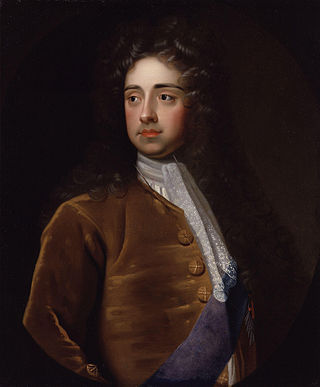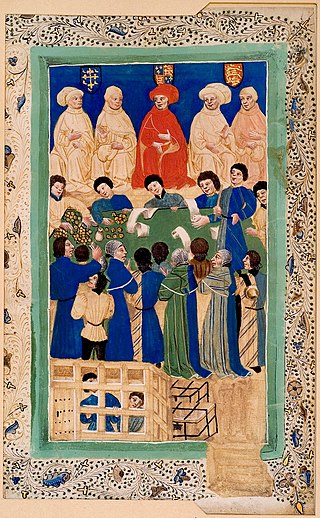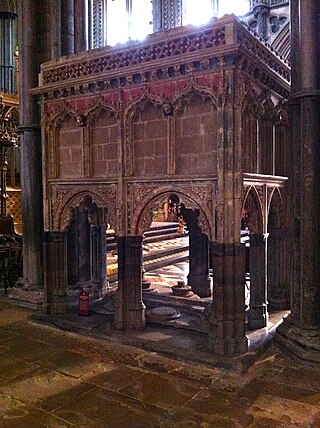Related Research Articles
Robert Malet was a Norman-English baron and a close advisor of Henry I.

Thomas Osborne,1st Duke of Leeds,was an English Tory politician and peer. During the reign of Charles II of England,he was the leading figure in the English government for roughly five years in the mid-1670s. Osborne fell out of favour due to corruption and other scandals. He was impeached and eventually imprisoned in the Tower of London for five years until James II of England acceded in 1685. In 1688,he was one of the Immortal Seven who invited William of Orange to depose James II during the Glorious Revolution. Osborne was again the leading figure in England's government for a few years in the early 1690s before dying in 1712.

The Lord High Treasurer was an English government position and has been a British government position since the Acts of Union of 1707. A holder of the post would be the third-highest-ranked Great Officer of State in England,below the Lord High Steward and the Lord High Chancellor of Great Britain.

The ruins of Linlithgow Palace are located in the town of Linlithgow,West Lothian,Scotland,15 miles (24 km) west of Edinburgh. The palace was one of the principal residences of the monarchs of Scotland in the 15th and 16th centuries. Although maintained after Scotland's monarchs left for England in 1603,the palace was little used,and was burned out in 1746. It is now a visitor attraction in the care of Historic Environment Scotland.

Charles Talbot,1st Duke of Shrewsbury was an English peer and Whig politician who was part of the Immortal Seven group that invited William of Orange to depose King James II of England during the Glorious Revolution. He was appointed to several minor roles before the revolution,but came to prominence as a member of William's government. Born to Roman Catholic parents,he remained in that faith until 1679 when—during the time of the Popish Plot and following the advice of the divine John Tillotson—he converted to the Church of England. Shrewsbury took his seat in the House of Lords in 1680 and three years later was appointed Gentleman-Extraordinary of the Bedchamber,suggesting he was in favour at the court of Charles II.

Robert Harley,1st Earl of Oxford and Earl Mortimer,KG PC FRS was an English statesman and peer of the late Stuart and early Georgian periods. He began his career as a Whig,before defecting to a new Tory ministry. He was raised to the peerage of Great Britain as an earl in 1711. Between 1711 and 1714 he served as Lord High Treasurer,effectively Queen Anne's chief minister. He has been called a prime minister,although it is generally accepted that the de facto first minister to be a prime minister was Robert Walpole in 1721.

Admiral of the Fleet Edward Russell,1st Earl of Orford,PC was a Royal Navy officer and politician. After serving as a junior officer at the Battle of Solebay during the Third Anglo-Dutch War,he served as a captain in the Mediterranean Sea in operations against the Barbary pirates.

The Exchequer of Pleas,or Court of Exchequer,was a court that dealt with matters of equity,a set of legal principles based on natural law and common law in England and Wales. Originally part of the curia regis,or King's Council,the Exchequer of Pleas split from the curia in the 1190s to sit as an independent central court. The Court of Chancery's reputation for tardiness and expense resulted in much of its business transferring to the Exchequer. The Exchequer and Chancery,with similar jurisdictions,drew closer together over the years until an argument was made during the 19th century that having two seemingly identical courts was unnecessary. As a result,the Exchequer lost its equity jurisdiction. With the Judicature Acts,the Exchequer was formally dissolved as a judicial body by an Order in Council on 16 December 1880.

William Paulet,1st Marquess of Winchester,styled Lord St John between 1539 and 1550 and Earl of Wiltshire between 1550 and 1551,was an English Lord High Treasurer,Lord Keeper of the Great Seal,and statesman.

Thomas Sackville,1st Earl of Dorset was an English statesman,poet,and dramatist. He was the son of Richard Sackville,a cousin to Anne Boleyn. He was a Member of Parliament and Lord High Treasurer.
Peter de Rivaux or Peter de Rivallis was an influential Poitevin courtier at the court of Henry III of England. He was related to Peter des Roches,being a nephew.

James Ley,1st Earl of Marlborough was an English judge and politician who sat in the House of Commons at various times between 1597 and 1622. He was Lord Chief Justice of the King's Bench in Ireland and then in England,and was Lord High Treasurer from 1624 to 1628. On 31 December 1624,James I created him Baron Ley,of Ley in the County of Devon,and on 5 February 1626,Charles I created him Earl of Marlborough. Both titles became extinct upon the death of the 4th Earl of Marlborough in 1679.

William Cecil,2nd Earl of Salisbury,,known as Viscount Cranborne from 1605 to 1612,was an English peer,nobleman,and politician.

Sir William Lee was a British jurist and politician.

John Hotham was a medieval Chancellor of the Exchequer,Lord High Treasurer,Lord Chancellor and Bishop of Ely. He was also the effective Governor of Ireland for a time.

Ralph Boteler,1st Baron Sudeley KG was an English baron and aristocrat who rose up through the ranks of the courts of King Henry V and Henry VI to become the Lord High Treasurer of England. He fought in the Hundred Years’War and was made the Captain of Calais;and was later present at the execution of Joan of Arc. He is most notably remembered for largely rebuilding the Manor of the More,later home of Queen Catherine of Aragon,and Sudeley Castle,the final home and resting place of Queen Katherine Parr.
Sir John Langstrother was Treasurer of England,prior of the Knights of St John in England,and Preceptor of Balsall.

John Norbury of Hoddesdon and Little Berkhamsted in Hertfordshire,was an English courtier,ambassador and Member of Parliament who served as Lord High Treasurer of England.

Sir William de Essendon,de Estdene or Eastdean was an English-born cleric,lawyer and Crown official,much of whose career was spent in Ireland in the reign of Edward I of England and his son. He served twice as Lord High Treasurer of Ireland,and had a high reputation for integrity and efficiency.